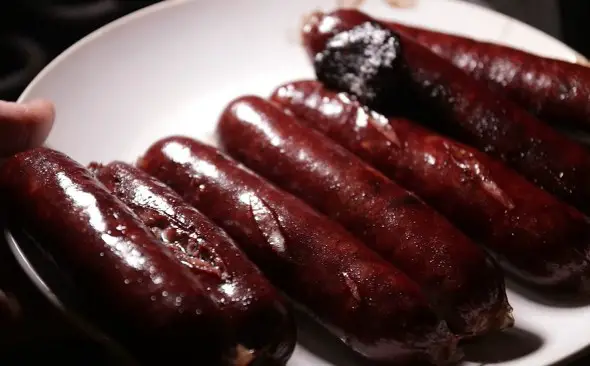Deer sausage isn’t just delectable; it’s also a top pick for those who love sausage and prioritize health.
Whether you acquire it from a nearby deli, your local supermarket, or craft it from scratch in your own kitchen, understanding the proper cooking techniques is crucial.
One common question that comes up is, “How long do you cook deer sausage?”
In this post, we will explore the different ways to cook venison sausage and share tips and tricks to help you prepare it to perfection.

Table of Contents
How Long Should Venison Sausage be Cooked?
Frying deer sausage stands as the most convenient and straightforward cooking method, requiring nothing more than a saucepan or skillet, a touch of oil or butter, and a well-heated stove. Follow these simple steps to achieve perfectly fried deer sausage links:
Heat a saucepan or skillet over medium heat and add a small amount of butter or oil.
Once the skillet is adequately heated, introduce the deer sausage links to the pan.
Cook the sausages for approximately 6-10 minutes, ensuring you turn them regularly to ensure even cooking.
Use a meat thermometer to check the internal temperature of the sausages, ensuring they reach the optimal range of 155°F – 165°F.
Once the sausages have reached your desired temperature, remove them from the pan, and allow them to rest for a few minutes before serving.
>Read: Do hickory farms gift boxes need to be refrigerated
How Long to Smoke Venison Sausage
When smoking venison sausage, it’s best to start by preheating the smoker to medium-high heat and cooking the sausage for approximately 5 minutes, turning it once.
Next, reduce the heat to a range of 160-180°F and allow the sausage to cook for a minimum of 2 hours.
To ensure the sausage is safe to eat, check that its internal temperature reaches between 155-165°F. Using a meat thermometer is a reliable method to determine when the sausage is ready.
Cooking the sausage slowly at a lower temperature helps prevent it from drying out.

How Long to Boil Venison Sausage?
Boiling is an unconventional yet effective method for cooking venison sausage. While there are both advantages and drawbacks to this approach, it offers a leaner option for those who favor healthier meats.
Boiling venison sausage can be a healthier alternative since it doesn’t require the use of additional fats. However, the trade-off is that you might miss out on the enticingly crispy, golden-brown skin that adds so much flavor to the sausages.
To boil venison sausage, place them in a pot, cover the sausage with water, puncture small holes in the sausages using a knife, and let them simmer for 20 minutes. Alternatively, you can briefly sear them in a pan before boiling in the same pan.
Frying venison sausage without adding extra fat is also an option. By puncturing small holes in the sausage, the natural fat within will render out, allowing you to achieve a crisper skin, if that’s your preference.

How Long to Bake Venison Sausage in the Oven?
If you’re seeking a hassle-free way to prepare your deer sausage, baking it in the oven proves to be an excellent choice.
Baking ensures thorough cooking of the sausages while keeping their casings intact. Furthermore, you have the freedom to experiment by incorporating other meats and vegetables to elevate the dish’s flavors.
Here’s a step-by-step guide to baking deer sausages:
Preheat the oven to 375°F and remove the sausages from the refrigerator.
Line the baking tray with aluminum foil or use cooking spray. Optionally, brush the deer sausages with butter or oil for added flavor.
Arrange them on the pan, ensuring ample space for even cooking.
Roast the sausages in the oven for approximately 15-20 minutes. Note that oven temperatures can vary, so be sure to adjust the baking time accordingly.
Feel free to get creative by introducing other ingredients to the dish, allowing you to craft your unique culinary masterpiece.
Cooking Duration for Venison Sausage on the Grill
When it comes to grilling venison sausage, the key factor is the cooking time. The heat of your grill will dictate how long, with the ideal cooking temperature being around 350°F.
Typically, the cooking duration falls within the range of 10 to 20 minutes, although this can vary based on the thickness of your sausage.
An important reminder while your sausages are on the grill is to turn them every two to three minutes. This ensures even cooking on all sides.
Furthermore, it’s essential to be cautious and avoid puncturing the sausages while turning them to prevent any unwanted drying out.
How to Tell When Deer Sausage Is Fully Cooked?

When it comes to cooking any type of meat, using a meat thermometer is the most reliable way to ensure that it is fully cooked and safe to eat.
This is especially important for wild game meats like venison, which can carry a higher risk of foodborne illness if not properly cooked.
To determine the internal temperature of your deer sausage links, insert a meat thermometer into the center of the thickest part of the sausage. Be sure not to touch bone or the bottom of the pan as this can give an inaccurate reading.
The internal temperature of the sausage should reach 155°F – 165°F (ideally 160°F) to ensure that it is fully cooked.
Ideal Storage and Handling Tips
Proper storage and handling of deer sausage are essential to prevent spoilage and contamination. Once opened, it is recommended to store the sausage in the refrigerator. However, unopened containers can be stored in the pantry
Before consuming, always check the packaging label for specific storage instructions. Some deer sausages may have additional requirements, such as freezing or refrigerating immediately after purchase.
Conclusion
The choice of cooking technique you opt for plays a pivotal role in determining the cooking duration of your deer sausage. Popular options include grilling, smoking, or baking in the oven.
However, several factors such as the size of the links, the type of sausage, and the fat content can also influence the required cooking time.
To ensure that your sausage is fully cooked, using a meat thermometer is highly recommended. Deer sausage should reach an internal temperature of 160°F before it is considered safe to serve. Relying solely on timing can result in sausages being either undercooked or overcooked.
With these guidelines in mind, you can now savor your deer sausage with confidence and satisfaction.
Cooking Deer Sausage
Deer Sausage, Cook, Meat, Deer, Cook Deer Sausage, Boil Deer Sausage, Boiling, Deer Sausages, Deer, Deer Sausage.
Cook venison sausages, sausage types, deer sausages, Sausage, Sausage, Sausage, Sausage, Sausage, Sausage, Sausage, Sausage, Sausage, Sausage, Sausage, Sausage, Sausage, Sausage, Sausage, Sausage, Sausage, venison, venison, venison, venison, venison, venison, venison, venison, deer, deer, deer, deer, deer, cook deer sausage, boil, boil.

Fernando is the creator and writer behind the food blog Eating with your Hands. Living and working in cities like Paris, Barcelona, and Berlin, and being married to a Canadian foodie, has given Fernando a passion and interest in food and inspired him to run EWYH.
